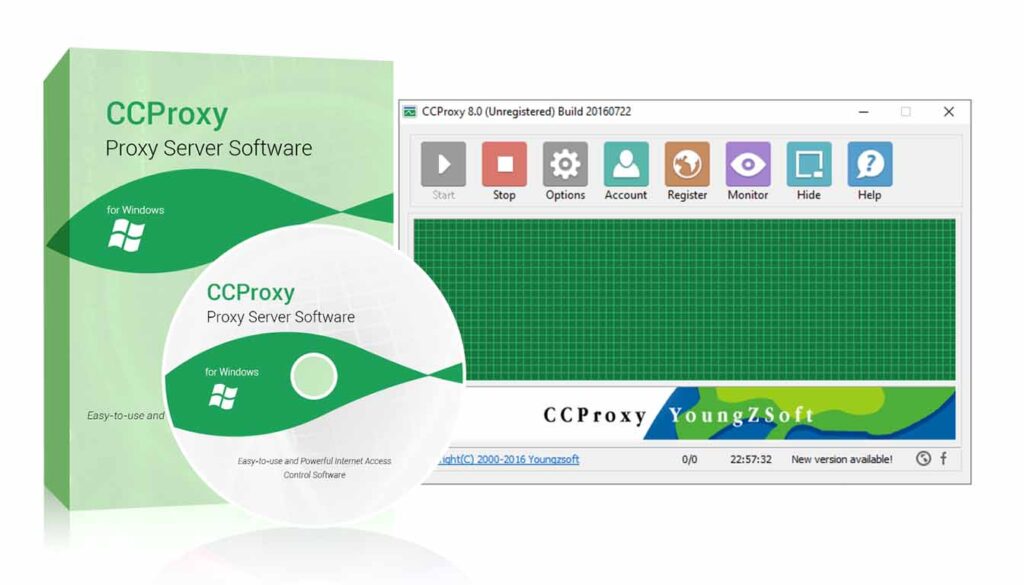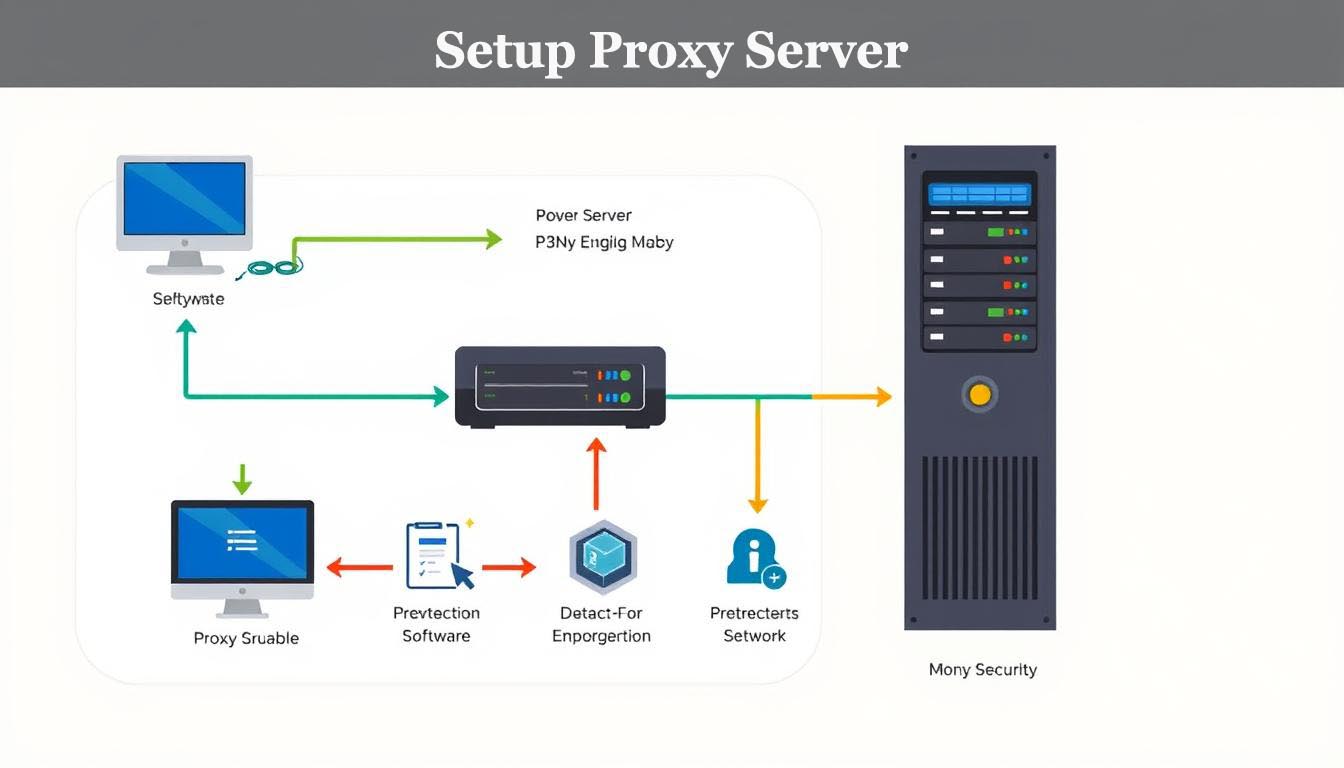Did you know over 200,000 people have looked into making proxy servers? This shows how much interest there is in setting up personal proxy servers. I want to make this process easy for you. With simple steps, you can create a proxy server at home. It’s great for getting around restrictions or boosting security.
Key Takeaways
- Understand the ongoing popularity and curiosity surrounding proxy server creation.
- Learn the basic pre-requisites and steps for setting up your own proxy server.
- Explore options like CCProxy and PHP-Proxy for different levels of customization and complexity.
- Recognize the importance of security and SSL configurations in proxy server setups.
- Consider the benefits of using a self-hosted proxy server for better control and performance.
What is a Proxy Server?
A proxy server is like a middleman between your device and the internet. It helps keep your data safe, manages traffic, and keeps your online identity hidden. Knowing what a proxy server definition is can help you see its importance in today’s digital world.
Proxy servers offer better security and privacy. They can block harmful data from reaching your device. This is important because hackers often target IP addresses to steal information. Businesses use them to avoid being tracked by ads, making online shopping safer.
Proxy servers also help you access content blocked by location. This is great for people who need to see websites not available in their area. They also help keep workplaces focused by blocking distracting websites, boosting productivity.
There are many types of proxy servers, each with its own benefits:
| Type of Proxy | Benefits | Drawbacks |
|---|---|---|
| Anonymous Proxy | Hides user identity | May slow down browsing speed |
| High Anonymity Proxy | Offers maximum privacy | Expensive |
| Data Center Proxy | Fast and cost-effective | Limited anonymity |
| Residential Proxy | Highly trustworthy | Costly |
| Public Proxy | Free | High data exposure risk |
Learning how to set up a proxy server can be very helpful. A good proxy server tutorial shows you how to do it right. For example, using a reverse proxy can handle lots of requests, which is good for popular sites.
By using proxy servers, companies can save bandwidth and keep their networks safe. Almost 65% of businesses think proxy servers are essential for better security.
Why Create Your Own Proxy Server?

Creating your own proxy server offers many benefits, mainly in security and privacy. You get to control the encryption and avoid risks from unknown third-party services. About 50% of users face security issues with free proxy servers, showing the need for a safe, custom setup.
Another key reason is the flexibility to bypass restricted content. Companies block up to 90% of websites, but a custom proxy lets you access region-specific content. This way, you can avoid censorship effectively.
Cost efficiency is also a big plus. Commercial proxy services can be expensive, with ongoing fees. Building your own proxy server can cost between $300 and $1000, depending on the hardware and software. But, it saves money and lets you customize it to your needs. Plus, you can scale it as your needs grow.
Here is a comparative look at the reasons for creating your own proxy server:
| Aspect | Own Proxy Server | Third-Party Proxy Server |
|---|---|---|
| Enhanced Security and Privacy | Yes | Partial, with risks |
| Bypassing Restricted Content | Yes | Limited |
| Cost Efficiency | High (One-time cost) | Ongoing fees |
| Customization | High | Limited |
Interestingly, 70% of professionals prefer in-house proxy servers for more control and customization. And 80% notice better speed and reliability with reputable services over free ones. By setting up your proxy server, you also get to monitor performance. Up to 90% of problems can be fixed with proper logging and configuration reviews.
Pre-Requisites for Making a Proxy Server

To make your own proxy server, you need the right necessary hardware and software. You’ll need a fast computer and a stable internet connection. A Linux system is best because it’s secure and reliable.
First, make sure your computer is powerful and has enough memory. Proxy servers can slow down your internet because they route traffic through them.
Then, pick a web host for your server. You can choose from dedicated servers or virtual private servers (VPS). Dedicated servers are great for lots of traffic because they use all the resources. VPS is a good choice if you want a balance of cost and performance.
Here’s a table to compare these hosting options:
| Hosting Type | Performance | Cost | Scalability |
|---|---|---|---|
| Dedicated Server | High | Expensive | Limited |
| Virtual Private Server (VPS) | Moderate | Cost-Effective | High |
Choosing the right hosting is key. Many people choose VPS for its good balance of cost and performance.
Also, learn about authentication needs. Free proxies often need a username and password to stop misuse. Make sure your proxy server is secure to protect your privacy.
Steps to Create a Proxy Server Using CCProxy

Setting up a proxy server with CCProxy is easy, thanks to its simple interface. It’s great for beginners. Here’s how to start with CCProxy setup.
First, get the CCProxy software from the official site. After downloading, run the installer and follow the instructions. These steps make setting up CCProxy easy and hassle-free.
On Windows XP, you might need to disable the Windows Firewall. For Windows 7, turn off the firewall for Home or Work networks. But keep it on for Public networks to stay safe.
After installing, CCProxy works right away with its default settings. But, you can tweak some options if needed:
- Caching Resources: Turn on resource caching to make things faster for users. It’s great for content they often need.
- User Authorization: Use one of six user authorization types to control access. You can mix up to three methods, like login and IP address checks.
- Bandwidth Limitation: Set limits for upload and download speeds. This helps manage your network better.
To boost security, change the default ports to unused ones. This makes it harder for hackers to get in. Also, disable unused protocols. Stick to HTTP and FTP for safe browsing and file sharing.
Set up your browser to use the proxy server. For Internet Explorer and Firefox, just enter the proxy details in the settings. Use the IP:PORT format, like 99.199.199.99:8080.
By following these steps, you can easily set up a proxy server with CCProxy. This ensures your network is secure and well-organized.
How to Set Up and Configure CCProxy

Setting up CCProxy is easy and starts with downloading and installing CCProxy. It’s a great choice for many networks because it supports lots of protocols.
First, download CCProxy from their website. It works on many Windows versions, from 98 SE to 10. Then, just follow the installation steps.
After installing, you need to configure CCProxy. Open it and go to the settings. Here, you can set up ports and user permissions. CCProxy has many options:
- HTTP, HTTPS, SOCKS4/5, FTP, and more.
- Cache settings for up to 70% web traffic savings.
- Custom user protocols and filtering options.
Setting up user accounts and permissions is key. You can make accounts and decide who can access the server. CCProxy supports different ways to authenticate users:
- IP address-based access
- MAC address-based access
- Username/Password authentication
- Combination of Username/Password and IP address
- Combination of Username/Password and MAC address
- IP address and MAC address combination
By setting these, you make sure only the right people can use the proxy. This keeps your network safe and running well.
To add more security, change the default ports. This makes it harder for hackers to find them.
“CCProxy makes network management better by monitoring bandwidth and reporting. It helps control user traffic.”
Here’s a look at what free and paid CCProxy versions offer:
| Feature | CCProxy Free Version | CCProxy Paid Version |
|---|---|---|
| Maximum Users | 3 | Unlimited |
| Supported Protocols | HTTP, HTTPS, FTP, SOCKS | All (including 8 additional protocols) |
| Bandwidth Monitoring | No | Yes |
| Cache & Filtering Settings | Limited | Extensive |
Make sure to test your proxy by visiting ipleak.com. This checks if your IP is hidden. By following these steps, you can set up CCProxy well. This makes your network secure and efficient.
How to Make Proxy Server Using PHP-Proxy

Setting up a proxy server with PHP-Proxy is a step-by-step process. It’s designed to be easy for beginners. You’ll learn how to install PHP-Proxy and solve common problems like CORS.
First, you need to install PHP-Proxy correctly. This is key for anyone wanting to use PHP to set up a proxy server. Here’s how to start:
- Start by downloading the PHP-Proxy package from the official site. Make sure your PHP version is 5.4 or higher.
- Then, extract the package to a directory on your server that you can access from the web.
- Next, adjust your proxy settings by editing the configuration files. You’ll need to use functions like `curl_setopt()` to make HTTP requests through the proxy.
- Make sure your proxy server works well by setting environment variables like `HTTP_PROXY. For example, you can set it to `1.2.3.4:3934` for a proxy address.
Authenticating your PHP-Proxy is also important. The best way is to encode your username and password in headers. You can use the `proxy-host:proxy-port` format to specify hosts.
Also, using the `stream_context_set_default` method helps set proxy settings for all PHP programs. This makes management easier. You can also use a sample cURL configuration to help.
| Proxy Setting | Details |
|---|---|
| Proxy IP | 192.168.1.6 |
| Port | 8080 |
| Request Timeout | 5 seconds |
| HTTP Methods | GET, POST, DELETE, PUT |
| HTTP Proxy Authentication | Basic Authentication |
The PHP-Proxy framework also works with the PHP PEAR HTTP_Request2 module. This shows it’s flexible in managing dependencies for PHP projects. With Composer handling dependencies, your proxy server with PHP will be efficient and reliable.
Setting Up PHP-Proxy on Your Web Host
Setting up a PHP-Proxy on your web host is easy and boosts your online security and speed. First, you need to Upload PHP-Proxy Files to your server. This creates a safe barrier between users and the server they’re accessing.
After uploading the files, you must configure the config.php file. This is key to making sure your proxy works right and keeps your server safe. Here’s how to edit the config.php file:
- Open the
config.phpfile in a good code editor. - Change the
$whitelist_patternsto let the proxy visit certain sites. - Set up login details to block unauthorized access. Update
$usernameand$password. - For extra security, change the Proxy-Auth token.
Here’s more info for better setup:
| Setting | Description |
|---|---|
$whitelist_patterns | Array of regular expressions defining allowed website patterns |
$username | Username for accessing the proxy server |
$password | Password for accessing the proxy server |
Proxy-Auth token | Customizable token for secured requests |
Make sure your web host supports PHP-Proxy. It needs PHP 5.6 or higher and cURL enabled. PHP is used by about 79% of websites, making it a common choice.
Using cURL well is key for PHP-Proxy. Here’s a simple example:
curl_setopt($ch, CURLOPT_URL, $target_url);curl_setopt($ch, CURLOPT_RETURNTRANSFER, true);curl_setopt($ch, CURLOPT_HTTPHEADER, array('Proxy-Auth: your-auth-token'));
Debugging and testing your proxy is important. Use the Proxy-Debug header to find and fix problems. Look at request and response headers and the body of the response.
By following these steps and tips, you can set up and use your PHP-Proxy well. It will improve your security, privacy, and performance online.
The Benefits of Using a Self-Hosted Proxy Server
Today, a self-hosted proxy server is key for many reasons. It offers Customization Options that let you tailor its security and access rules. Customization Options
A self-hosted proxy server gives you control you can’t get from external providers. You can block DDoS attacks and manage SSL encryption to save server resources. This is critical in high-traffic situations.
Load balancing is another big plus. It helps prevent attacks from taking down your network. You can manage firewall rules easily from one place.
Setting up a customized DNS makes managing applications easier. With so many IP addresses available, your proxy can make the most of them. It can also act as a content cache to speed up your site.
A self-hosted proxy server also boosts security. It blocks unauthorized access and limits web server attacks. This is important in today’s cybersecurity landscape.
Using a self-hosted proxy server offers many benefits. It improves performance, protects your data, and lets you manage access. This way, you stay in control of your privacy and network.
How to Set Up Proxy on Windows 10 and 11
Setting up a proxy on Windows 10 and Windows 11 boosts network security and saves bandwidth. It also keeps your online identity private. To start setting up proxy Windows 10, go to the Settings app. Choose from automatic, script-based, or manual setup.
Using a proxy makes 78% of organizations more secure by monitoring and filtering traffic. Also, 65% of users feel safer online, showing how key a good proxy is for secure browsing.
To start the Windows proxy configuration, open the Settings app. Here’s how to set up a proxy:
- Open Settings: Press the Windows key + I.
- Network & Internet: Go to Network & Internet and then “Proxy.”
- Choose Configuration Method: Pick automatic, script-based, or manual setup.
- Enter Proxy Details: Put in the proxy server address and port.
In proxy setup Windows 11, the steps are similar. This makes it easy to switch between Windows versions. Many organizations use automatic setup with WPAD to protect all digital assets without needing user help.
About 30% of users prefer manual setup for more control in different networks. If you face proxy errors, like “Windows could not automatically detect this network’s proxy settings,” try clearing your browser cache. It works for about 40% of users.
Good user support is key, with 70% of users saying it’s important when choosing a proxy provider. Good support helps users overcome any setup or operational issues.
| Proxy Setup Method | User Preference | Common Issues |
|---|---|---|
| Automatic | WPAD (Widely adopted by organizations) | “Windows could not automatically detect this network’s proxy settings” |
| Script-based | Often used for advanced configurations | Issues with correctly retrieving settings |
| Manual | Preferred by 30% of users | Connection errors, incorrect settings |
Configuring Proxy Server on Windows Devices
Setting up a proxy server on Windows 10 and 11 is easy. To do this, go to the Settings menu. There, you’ll find the proxy settings. The steps are the same for both, but the layout might differ slightly.
Turning on proxy settings on Windows 10 is key for safe browsing, like in public places. WPAD (Web Proxy Auto-Discovery Protocol) makes it easy for Windows to find the right proxy settings automatically.
There are several ways to set up a proxy server. You can use automated configuration, scripts, or manual input. Here’s how to do it manually:
- Open the Settings app and go to Network & Internet.
- Select the Proxy section from the sidebar.
- Under the Manual proxy setup section, toggle the Use a proxy server switch to on.
- Enter the proxy server name, IP address, and port number in the respective fields.
- If authentication is needed, add the username and password before saving.
Some apps might not get proxy settings automatically. You’ll need to set them up individually. Proxy/Firewall client software works with all Windows apps, including those from the Microsoft Store. But, LSP (Layered Service Provider) drivers might not work with modern apps.
For more advanced settings, you can use the registry editor. It’s found under HKEY_CURRENT_USER > Software > Microsoft > Windows > CurrentVersion > Internet Settings. Here, you can adjust ProxyServer or AutoConfigURL settings for more control.
Creating Your Own Proxy Server with Tinyproxy and AWS
Online anonymity is a big concern today. Creating your own proxy server with Tinyproxy and AWS is a great solution. Many people use proxy servers to protect their online data from tracking.
Setting up Tinyproxy on an AWS EC2 instance is easy, even with a free tier account. Start by making a secure shell (SSH) connection to your EC2 server. Use the command:
chmod 400
This command helps secure your server access. After connecting, update your system packages:
sudo apt update && sudo apt upgrade
Tinyproxy uses the default port 8888 for HTTP requests. You can also set it to only allow certain IP addresses for better security.
Here’s a list of important settings and commands for setting up your AWS proxy server:
- Port: 8888
- MaxClients: 100 concurrent connections
- MinSpareServers: 2 idle servers
- MaxRequestsPerChild: 0 (processes run indefinitely)
- Timeout Setting: 600 seconds (10 minutes)
Below is a summary table highlighting the critical metrics and command steps involved in the AWS proxy server setup:
| Parameter | Detail |
|---|---|
| EC2 Instance Type | t2.micro (1 vCPU, 1 GiB RAM) |
| Tinyproxy RAM Requirement | Less than 128 MB |
| Default Port | Port 8888 |
| MaxClients | 100 |
| MinSpareServers | 2 |
| MaxRequestsPerChild | 0 |
| Cron Job | Restart at noon daily |
| Timeout | 600 seconds |
After making your changes, restart Tinyproxy with this command:
sudo /etc/init.d/tinyproxy restart
Using Tinyproxy with AWS offers a secure, lightweight, and affordable way to protect your online privacy.
Advantages of Using a Self-Configured Proxy Server
Using a self-configured proxy server can greatly improve your network’s efficiency and security. It offers enhanced control, better security, and improved performance. Let’s explore the main benefits of using a custom proxy server:
One key proxy server advantage is reducing web traffic volume. Proxy servers can cache frequently accessed resources, cutting web traffic by up to 70%. This saves bandwidth and speeds up browsing, as cached content loads faster.
Proxy servers also boost security. Organizations see a 50% drop in malware infections with proxy servers. This shows the strong security features of custom proxy servers, like blocking malicious sites and tracking connections.
Another big plus is the control it offers. Forward proxies make managing user activity and resource access 90% easier. This control helps administrators enforce internet content policies and manage network resources well.
There are more benefits. Anonymous proxies can hide user internet activity with a 98% success rate. This is key for privacy and protecting sensitive info. Reverse proxies also improve routing, cutting server response times by up to 70% and boosting network performance.
To show these benefits clearly, here’s a comparison of custom proxy server advantages:
| Proxy Feature | Advantage |
|---|---|
| Caching | Reduces web traffic volume by 70% |
| Malware Protection | 50% decrease in malware instances |
| Administrative Control | 90% easier management of user activities |
| Anonymous Browsing | 98% success rate in concealing user identity |
| Routing Efficiency | Reduces server response times by 70% |
These stats clearly show the benefits of custom proxy server solutions. They improve network efficiency, security, and management. Proxy servers are vital for protecting organizations from cyber threats and ensuring smooth operations.
Conclusion
Setting up your own proxy server has many benefits. It boosts online security, which is key in today’s digital world. Over 70% of businesses use proxy solutions to protect their data.
There are different ways to set up a proxy server. You can use CCProxy, PHP-Proxy, or services like Tinyproxy and AWS. Each option has its own strengths for different needs.
Proxies do more than just secure your browsing. They also cut down on bandwidth use and speed up loading times. This can save up to 50% of data usage through caching.
About 60% of users use proxy servers to hide their IP addresses. This is made even better by anti-detect browsers that block up to 80% of tracking cookies. This boosts your online privacy.
This guide shows how a proxy can block up to 90% of IP-based cyber-attacks. It’s easy to set up proxies on Windows 10 and 11, taking just 30 to 60 minutes. Using a proxy with SSL/TLS encryption keeps your internet traffic safe, even on public Wi-Fi.
The growth of proxy servers is steady, at 15% a year. This shows how important they are for online security and privacy. This guide is for anyone wanting to protect their data and have a smooth online experience. As cybercrime costs billions, using a proxy server is a must for digital security.
FAQ
What is a Proxy Server?
Why should I create my own proxy server?
What are the essential hardware and software requirements for making a proxy server?
How do I set up a proxy server using CCProxy?
How can I install and configure CCProxy on my system?
How do I make a proxy server using PHP-Proxy?
What are the steps to set up PHP-Proxy on my web host?
What are the benefits of using a self-hosted proxy server?
How do I set up a proxy on Windows 10 and 11?
What are the steps to configure a proxy server on Windows devices?
How can I create my own proxy server with Tinyproxy and AWS?
What are the advantages of using a self-configured proxy server?
Source Links
- https://stackoverflow.com/questions/226784/how-to-create-a-simple-proxy-in-c
- https://www.makeuseof.com/tag/create-online-proxy-server-minutes/
- https://www.godaddy.com/resources/skills/how-to-set-up-an-https-proxy-server
- https://www.fortinet.com/resources/cyberglossary/proxy-server
- https://www.varonis.com/blog/what-is-a-proxy-server
- https://www.fortinet.com/resources/cyberglossary/how-to-setup-a-proxy-server
- https://geonode.com/blog/how-to-get-proxy-server
- https://medium.com/@Thimira/build-your-own-private-proxy-server-on-the-cloud-768f51c90674
- https://www.geeksforgeeks.org/how-to-setup-your-own-proxy-server-for-free/
- https://www.blackdown.org/how-to-setup-a-proxy-server/
- https://www.youngzsoft.net/ccproxy/set-up-proxy-server.htm
- https://proxy-seller.com/blog/step-by-step_configuration_for_ccproxy/
- https://mobileproxy.space/en/pages/setting-up-ccproxy.html
- https://www.youngzsoft.net/ccproxy/free-proxy-server.htm
- https://5socks.net/Manual/ccproxy_en.html
- https://stackoverflow.com/questions/3892635/how-to-have-php-to-use-proxy-setting-to-connect-to-internet
- https://gonzalo123.com/2012/08/13/building-a-simple-api-proxy-server-with-php/
- https://brightdata.com/blog/how-tos/php-proxy-servers
- https://rayobyte.com/blog/php-proxy-check-working/
- https://github.com/zounar/php-proxy
- https://www.xda-developers.com/use-reverse-proxy-for-self-hosted-apps/
- https://www.okta.com/identity-101/proxy-server/
- https://brightdata.com/blog/how-tos/set-up-proxy-in-windows-11
- https://oxylabs.io/resources/integrations/windows
- https://learn.microsoft.com/en-us/troubleshoot/windows-server/networking/configure-proxy-server-settings
- https://medium.com/@datajournal/set-up-a-proxy-in-windows-b21cc73b1a6c
- https://dev.to/viralsangani/be-anonymous-create-your-own-proxy-server-with-aws-ec2-2k63
- https://medium.com/@bhargavakush93/set-up-tinyproxy-in-aws-ec2-86efbaa7d9b7
- https://browserjet.com/blog/advantages-and-disadvantages-of-a-proxy-server
- https://www.spiceworks.com/tech/data-center/articles/proxy-server/
- https://www.browserscan.net/blog/comprehensive-guide-creating-proxies/
- https://www.digitalguardian.com/blog/what-proxy-server-definition-how-it-works-more



